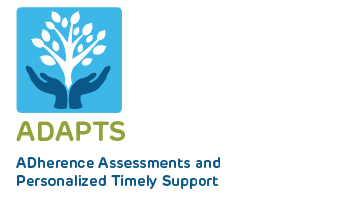HOW CAN WE HELP YOU? Call 1-800-TRY-CHOP
In This Section
How Technology Can Help Teens With Cancer Adhere to Treatment

The ADAPTS app aims to help adolescents and young adults with acute lymphoblastic leukemia and lymphoma adhere to their oral chemotherapy regimen.
The teenage years can be tough, and being a teen asked to take daily oral chemotherapy can be even tougher. On top of the growing pains that often accompany adolescence, a variety of reasons make it difficult to follow chronic disease recommendations, from family dynamics, to side effects, to mood swings — all of which can vary across and within individuals on any given day.
At Children’s Hospital of Philadelphia, Alexandra Psihogios, PhD, who is a pediatric psychologist and behavioral scientist, is approaching this unique adherence challenge with the help of something most teens already know a little something about: an app. With support from the National Cancer Institute’s Mentored Clinical Scientist Research Career Development Award, Dr. Psihogios is harnessing mobile health (mHealth) to help adolescents and young adults with acute lymphoblastic leukemia (ALL) and lymphoma follow treatment regimens through a more personalized, approachable, and efficient way.
“Whether it's a cancer population, diabetes, or any chronic health condition, we tend to observe the same pattern that about half of teens and young adults don't follow medical prescriptions exactly as prescribed,” Dr. Psihogios said, who is also on faculty in the Perelman School of Medicine at the University of Pennsylvania. Nonadherence can pose significant health risks such as increasing the risk for cancer relapse. “It’s often not only characteristics of the patient that can impact their adherence, but other multi-level processes: how their family communicates, how much oversight caregivers have over medication, and of course, the health system as a whole — how affordable are the medications? Are there gaps in access, especially for young adults transitioning off their parents’ insurance?”

The ADAPTS app will use daily surveys to personalize messages to adolescents and young adults in real-time.
Addressing the many fluctuating factors at play, Dr. Psihogios will test the feasibility and acceptability of the ADherence Assessments and Personalized Timely Support app (ADAPTS), an adaptive, “just-in-time” intervention that works just like its name implies. The app will use daily surveys (ecological momentary assessment; EMA) to personalize messages in real-time (i.e., delivering a medication reminder when a patient is outside of the home and prone to forget).
“I feel very passionate about trying to develop tools that not only help with adherence, but give adolescents control in a situation that often feels pretty out of control,” Dr. Psihogios said. “If we can try to help them stay on track developmentally and also feel like they're becoming more independent and have a say over their health — that’s my favorite kind of work to do.”
Capturing Fluctuating Factors in Nonadherence
Most traditional surveys about adherence don’t capture the more nuanced and various reasons an individual teen might miss their medication. Because they’re administered only once or twice, these surveys fail to capture the factors that shift from day to day, such as mood, adherence motivation, and recent interactions with family. EMA is more powerful than previous survey methods because it involves frequent sampling of an individual’s current behaviors and experiences closer to the time and context it seeks to address — in this case, taking oral chemotherapy. Using the ADAPTS app, Dr. Psihogios and her team aim to capture those variabilities in real time and in a more frequent and repeated manner.
“We are trying to understand on a given day, the characteristics that increase the risk of missing a dose of oral chemotherapy,” Dr. Psihogios said. “And can we intervene on that factor, at the right time, for those who need more adherence support?”
The app, adapted from another originally designed at Harvard University, is designed to receive input from users in an approachable way, a virtual world with animals and plants that becomes more enriching after each survey. Participants also will receive funny memes, inspirational quotes, and other rewards for completing surveys.
Providing Personalized Feedback
Each afternoon for 28 days, adolescents and young adults in the study will open their app and complete the short EMA surveys. These EMA responses include information about the participants’ mood, physical symptoms, motivation, and recent family interactions, as well as more objective data such as where they are and whether it’s a weekend or weekday.
This information is valuable, as Dr. Psihogios’ team will use the variables that they’ve identified as significant to develop and deliver contextually tailored messages triggered by these responses. The idea stems from the adult health literature, where researchers have tested adaptive interventions for other health behaviors such as alcohol abuse. In that scenario, an intervention sends messages when an individual is near their favorite bar.
If the researchers learn, for example, that daily fluctuations in negative mood are robust factors when it comes to nonadherence, they would want a bank of mobile messages sent only on days when an individual reports high negative mood.
“The idea of these adaptive interventions is similar to targeted advertising,” Dr. Psihogios said. “We’re using the data that you’re inputting to trigger personalized recommendations. We’re outputting an adherence promotion message that’s tailored to that context that day. And if on that given day, you don’t have any risk factors for nonadherence — we estimate with a degree of confidence that you’re going to take your medication — we don’t send anything. Because if you send messages to individuals every day, they tend to habituate and stop paying attention.”
After receiving a message, the participants acknowledge they received the message by pressing either a "thumbs up" or "thumbs down" button (indicating whether or not they liked the message), or a "snooze" button (indicating that it was not a good time to receive the message).
Optimizing Technology to Support Patients
After working with the app for a month, study participants will provide feedback on the intervention. In particular, Dr. Psihogios and her team plan to assess the feasibility and acceptability of the app by looking at the percentage of participants who acknowledged their mobile messages, technical difficulties within the app, the number of completed assessments, retention rates, and more.
Beyond its primary goal of promoting oral chemotherapy adherence, Dr. Psihogios said studying the app also will help to inform how to develop low-cost yet efficient mHealth interventions. In the current research project, participants will receive a small monetary incentive after completing surveys on the app. Realistically, however, spending a certain amount of money per person would be challenging clinically.
“A subset of the project is also testing the efficacy of no-cost or low-cost strategies for improving engagement in a mobile health tool,” Dr. Psihogios said. “There are broader implications because we know that people tend to download health apps, keep it for a week, then delete. So, we’re trying to understand if we can improve engagement without relying exclusively on financial incentives.”
The study is currently recruiting participants. In the meantime, Dr. Psihogios looks forward to finding new ways to use and optimize technology to address concerns she sees in the oncology clinic. As co-founder and co-chair of the Society of Pediatric Psychology’s Digital Health Special Interest Group, Dr. Psihogios views digital platforms, including mobile health, as a fruitful way of addressing behavioral health needs and supporting patients.
“Technology is changing rapidly, and the healthcare system is trying to catch up,” Dr. Psihogios said, “but teenagers are native explorers!” Dr. Psihogios said. In addition to developing new apps, there are opportunities for clinicians to expand their knowledge of the evidence-based mHealth apps that are already available to the public in the Apple iTunes and Google Play stores. “These apps hold the potential to bridge gaps in behavioral healthcare and complement in-person therapies. It provides patients with the opportunity to practice skills in the real world, where health behaviors are actually taking place.”